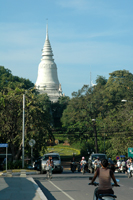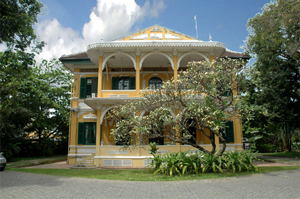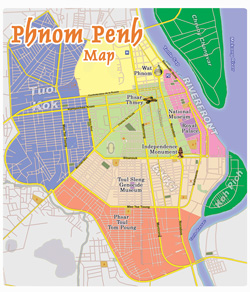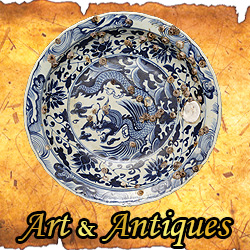|
A Brief History of
Phnom Penh
 Chaktomuk... Chaktomuk...
People have inhabited parts of Southeast Asia since the early Stone Age, and the ancestors of the Khmer people have been in the area for at least
5000 years, perhaps much longer, but there is no firm evidence of
settlements in the Phnom Penh area prior to about 2000 years ago. Though
probably an active settlement in Cambodia's golden age of Angkor
(9th-15th century AD,) Phnom Penh does not enter the historical record
until after it became the Khmer capital in the mid 15th century AD. At
the time it was known as Chaktomuk - the 'Four Faces' - so called for
its location at the four-branched confluence of the Mekong River. The
chaktomuk is a riverine crossroads in the heart of Cambodia with the
Tonle Sap River running northwest to the old Angkorian capital, the
Mekong River north to Laos and branches south to the delta and the South
China Sea. Phnom Penh is, before all else, the city at Chaktomuk on the
Mekong River....
|

 Legendary
Beginnings Legendary
Beginnings
First recorded a century after it is said to have taken place, the
legend of the founding of Phnom Penh tells of a local woman, Old Lady
Penh (Duan Penh,) living at the chaktomuk, the future Phnom Penh. It was
the late 14th century and the Khmer capital was still at Angkor near
Siem Reap 350km to the west. Gathering firewood along the banks of the
river, Lady Penh spied a floating koki tree in the river and fished it
from the water. Inside the tree she found four Buddha statues and one of
Vishnu (the numbers
vary on different tellings.) The discovery was taken as a divine
blessing, and to some a sign that the Khmer capital was to be brought to
Phnom Penh from Angkor. To house the new found
sacred objects, Lady Penh raised a small hill on the west bank of the
Tonle Sap River and crowned it with a shrine, now known as Wat Phnom at
the north end of central Phnom Penh. 'Phnom' is Khmer for 'hill' and the
Lady Penh's hill took on the name of the founder, i.e. Phnom Duan Penh,
and the area around it became known after the hill - Phnom Penh. numbers
vary on different tellings.) The discovery was taken as a divine
blessing, and to some a sign that the Khmer capital was to be brought to
Phnom Penh from Angkor. To house the new found
sacred objects, Lady Penh raised a small hill on the west bank of the
Tonle Sap River and crowned it with a shrine, now known as Wat Phnom at
the north end of central Phnom Penh. 'Phnom' is Khmer for 'hill' and the
Lady Penh's hill took on the name of the founder, i.e. Phnom Duan Penh,
and the area around it became known after the hill - Phnom Penh.
 History History
Cambodia is the land of the Khmer,
the dominant ethnic group in the area stretching from the present deep
into prehistory. The
Angkorian
era Khmer Empire centered near Siem Reap dominated the region from the
9th-13th century AD, at its apex the Empire stretched across most of
mainland Southeast Asia. But by the 15th century the Empire was in
political and territorial decline and under challenge from the rising
Tai kingdom of Ayudhaya in today’s Thailand. By the 14th century
Ayudhaya was staging regular incursions, culminating with the sack of
Angkor in 1431-32. Shortly thereafter the Khmer court of King Pohea Yat
left the Angkorian capital and established a new capital at Phnom Penh.
With a very brief exception, the capital would never return to Angkor.
The choice to move the capital to Phnom Penh at the confluence of the
Mekong was probably not only a strategic response to Ayudhhaya’s
aggression but may have also reflected a tectonic economic shift. The
15th century was the beginning of a general rise in international
commerce throughout the region and Phnom Penh was an ideal location for
a trade center. The move may have reflected the country changing focus
from the old Angkorian agrarian economy based in the country’s interior
to a trade oriented economy based in a riverine port town.
During the first Royal occupation of Phnom Penh in the mid 15th century,
King Pohea Yat set the foundations of city, establishing several wats
and laying out the town along moats/rivers which approximate the area
and layout of modern central Phnom Penh. Wat Ounalom on the riverfront
near the Royal Palace may even slightly pre-date King Pohea Yat, making
it the oldest known Buddhist foundation in the city.
Phnom Penh
Trade with China and other Asian kingdoms was well established in the
Angkorian-era long before Phnom Penh was the capital. Boats traveling
upriver to Angkor would pass Chaktomuk (Phnom Penh) which, due to its
favorable location, was probably an active settlement at the time. After
the capital moved from Angkor to Phnom Penh in the mid 15th century, the
city remained the capital only briefly. Before the century was out, the
capital had been relocated to Longvek 46km upriver. Though it moved a
few more times in the subsequent centuries (primarily between Longvek
and Oudong,) the capital always remained within a few tens of kilometers
of the Chaktomuk area.
Maritime trade increased dramatically throughout the region in the late
15th century, with international players from as far as Japan. Though
the capital had moved from Phnom Penh, the town remained the center of
international commerce for Cambodia. Sixteenth century Spanish and
Portuguese records paint a picture of small but cosmopolitan port of
trade hosting significant populations of Chinese, Malay, Cham, Japanese
and some Europeans, all living in separate camps in and around the Phnom
Penh area. Structures of wood and bamboo crowded the west bank of the
Tonle Sap river and the great stupa on the hill of Wat Phnom was visible
from the river, marking the town to arriving visitors.
Arriving in the early 16th century, the Portuguese and Spanish were the
first Europeans to make contact with Cambodia, sending missionaries,
establishing trade and eventually becoming deeply involved in the
affairs of the Cambodian court. At the center of the drama were two
larger-than-life characters, Spaniard Blaz Ruiz, Portuguese Diogo Veloso
and their band. Arriving in the 1580s they ingratiated themselves to the
Cambodian King, served him as a sort of Praetorian guard, were captured
and then escaped the Siamese, retuned and murdered the new Khmer leader,
fled to Laos, installed a new Khmer king in Cambodia, and amidst rising
tensions, both died in 1599 coming to the aid of their compatriots in a
battle between the Malay and Cambodians against the Spanish in Phnom Penh. The
battle resulted in a massacre of the Spanish, bringing Spanish influence
in Cambodia to an abrupt and permanent end.
In the 17th century, Phnom Penh continued to prosper and the Dutch East
India Company became the dominant European trading partner, but this
relationship also came to a dire end in Phnom Penh. In a tale less
colorful than the Spanish adventure, after a lengthy trade and
diplomatic dispute between the Dutch and the King of Cambodia,
negotiations came to violence. A Company embassy was killed and captives
taken. The Company sent war ships to force the issue with the King at
Longvek. Once the ships had passed Phnom Penh on their way up the Tonle
Sap, the Cambodians built two bridges across the river behind them,
effectively blocking the river. Upon returning downstream the Dutch
ships were trapped by the bridges at Phnom Penh and besieged by fire
from both banks. They fought their way through in a day long battle but
suffered very heavy losses. Like the Spanish, Dutch influence in
Cambodia never recovered. Though the first British and French explorers
would arrive in the mid 17th century, European interest in Cambodia
waned until the French in force returned in the late 19th century.
The 19th Century
Squeezed between Siam and Vietnam, the 18th and 19th centuries were hard
on Cambodia. At the beginning of the 19th century the capital returned
to Phnom Penh for the first time in 300 years, but again only briefly.
In 1813, during a period of Vietnamese influence, King Ang Chan built
the palace Banteay Kev in Phnom Penh, but it burned in 1834 when a
retreating Siamese army razed the city. The capital subsequently moved
back to Oudong 35km away. It was not until the French arrived in the
1860s that it returned to Phnom Penh once again, this time permanently.
At the time the area had a population of about 10,000 including a large
Chinese sector as well as many other foreigners. It was a multi-ethnic
port town of floating villages and wooden and bamboo houses, huts, shops
and vendors lining a complex of paths and a single main road paralleling
the riverfront. After a brief visit in 1859, traveler Henri Mouhot
dubbed Phnom Penh “the great market of Cambodia."
 L'Indochine
française L'Indochine
française
France gained colonial control of much of mainland Southeast Asia
beginning in the 1860s, first taking portions of Cochin-china (southern
Vietnam,) then Cambodia and the remainder of Vietnam and Laos, finally
coalescing in 1887 into a federation of protectorates called French
Indochina. Cambodia first came into the French sphere in 1863. Seeking
assistance fending off Siam and Vietnam, and under pressure from France,
Cambodian King Norodom signed a Protectorate agreement with France in
August 1863. On French encouragement, the seat of government was
officially moved from Oudong to Phnom Penh in 1866. It was only then
that the city first began to take on the appearance of modern Phnom
Penh.
The first modern stone structure to be built was the Royal Palace,
opening in 1870. Soon thereafter the first stone 'Chinese
shophouse-style’ buildings were constructed, initially appearing along
the riverside near the Palace. The shophouse design is present across
Southeast Asia and ubiquitous in Phnom Penh, characterized by rows of a
deep, narrow apartment made up of a combined ground-floor businessfront
and upstairs residence.
By the 1880s, early colonial buildings clustered near Wat Phnom but most
of the rest of the city was a swampy place of wooden and bamboo
buildings. In the 1880/90s fires periodically swept through sections of
town, capped by the Great Fire of May 1894. After that brick and cement
became the standard for new buildings. The 1890s saw an expanding
population (50,000) and accelerated development including draining
wetlands, constructing canals and bridges, expanding the Grand Rue along
the river and the addition of several buildings such as the Post Office
and Treasury Building which still exist today. The city stretched from
the French Quarter around Wat Phnom south to Sihanouk Blvd, most
squeezed within a few hundred meters of the river.
The 20th
Century...
France remained in control of Cambodia for most of the first half of the
20th century. Many classic colonial buildings were constructed including
the Police Station (next to the Post Office,) the Hotel Le Royal and the
large villas around the Royal Palace. By the 1930s the canals had been
filled and turned into garden boulevards, which are now parks along
Sihanouk Blvd and also Streets 108/106. As the population grew (109,000
in 1939) the city continued to expand, mostly westward into the
wetlands, which were drained accordingly.
In 1935 the Boeung Deco lake was filled and the distinctive, domed, art
deco 'Central Market' (Phsar Thmey) was built in its place, originally
known as the ‘Grand Market’ when it opened in 1937. That same year the
cyclo-pousse, the iconic bicycle rickshaw known the ‘cyclo’ was first
introduced in the city. This was Phnom Penh at its colonial apex,
reputed to be the most beautiful city in French Indochina.
 Independence
from France came in 1954, issuing in a period of considerable urban and
commercial development and the beginning of the distinctive 'New Khmer
Architecture,' reflected in existing structures such as the Independence
Monument and Chaktomuk Theatre. Factories, roads, markets, power plants
and hundreds of shophouse-style apartments were built, giving the city
much of its current appearance. This all came to an abrupt end with the
Lon Nol coup of 1970 and Cambodia's descent into war between the
government and the communist Khmer Rouge (KR.) As the Khmer Rouge took
over the countryside in the early 1970s Phnom Penh became swollen with
refugees. In 1974 the city was lain siege and eventually cut off,
finally falling to the Khmer Rouge on April 17, 1975. Three days after
the fall the city was totally evacuated, leading to thousands of deaths.
Though some workers and Khmer Rouge remained in Phnom Penh, the city was
essentially a ghost town until the Khmer Rouge fled the invading
Vietnamese army December 1978-January 1979, leaving behind evidence of
their horrors such as the S-21 facility, now known as the Tuol Sleng
Genocide Museum. Independence
from France came in 1954, issuing in a period of considerable urban and
commercial development and the beginning of the distinctive 'New Khmer
Architecture,' reflected in existing structures such as the Independence
Monument and Chaktomuk Theatre. Factories, roads, markets, power plants
and hundreds of shophouse-style apartments were built, giving the city
much of its current appearance. This all came to an abrupt end with the
Lon Nol coup of 1970 and Cambodia's descent into war between the
government and the communist Khmer Rouge (KR.) As the Khmer Rouge took
over the countryside in the early 1970s Phnom Penh became swollen with
refugees. In 1974 the city was lain siege and eventually cut off,
finally falling to the Khmer Rouge on April 17, 1975. Three days after
the fall the city was totally evacuated, leading to thousands of deaths.
Though some workers and Khmer Rouge remained in Phnom Penh, the city was
essentially a ghost town until the Khmer Rouge fled the invading
Vietnamese army December 1978-January 1979, leaving behind evidence of
their horrors such as the S-21 facility, now known as the Tuol Sleng
Genocide Museum.
When people returned to the city after the Khmer Rouge period, it was a
shambles, largely intact but thoroughly looted and neglected. Restarting
the city began from scratch. As low level war continued in the western
provinces, the 1980s saw Phnom Penh repopulated and revitalization
begun. The city was scoured and basic services were re-established.
Phnom Penh’s population grew from 100,000 at the end of 1979 to 615,000
by 1990.
In 1991 UNTAC (United Nations Transitional Authority in Cambodia) began
its 2 year administration of the country as part of a UN brokered peace
agreement leading to national elections in 1993. After years of
isolation, Cambodia was suddenly open for business. International
investment started to flow into the country and Cambodia was back the
tourist map as the newest adventure destination. The city saw the
beginning of a period of economic and urban development that has
continued to this day. There was a flurry of new construction in the
1990's including most of the distinctive 'wedding cake villas.' With the
final demise of the Khmer Rouge in 1998 and increased stability,
development accelerated. The 2000's have seen another boom in Phnom
Penh. The city’s population has increased to near 2,000,000, there has
been significant infrastructure improvement and recently the first high
rise structures have been built, giving considerable change to the
skyline and architectural character of the city. Phnom Penh is now a
city in the midst of rapid change.
|



|


